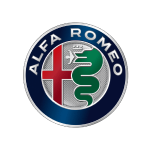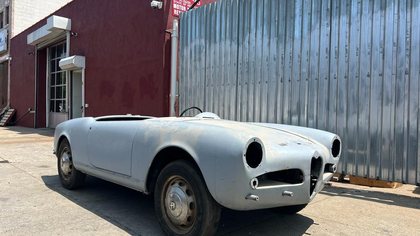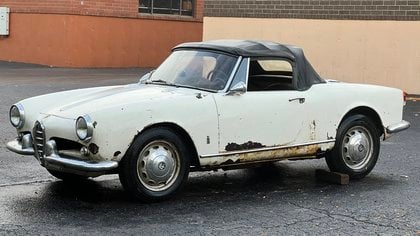Description
[Alfa Romeo Giulietta Spider Veloce, prototype, Alfa red, 1956] Prototype of the Veloce used in the Alfa Romeo Experiences Department, well-known car, ASI, FIVA and RIAR homologated The story of this car begins on 20 September 1956, the day of its production, with the number 194: this Giulietta Spider is an experimental car, taken from the Experiences Department (S. E. S., Servizio Esperienze Speciali) for internal use, with the aim of testing the nascent 'Veloce', transforming it to all intents and purposes into a 'Spider Veloce', one of the oldest still in existence, as stated on the manufacturer's certificate of origin.
After a couple of years of experimentation both on the engine with these specifications, and on the transmission, the car was registered: on 30 June 1958 it received its first number plate - Milano -, registered directly to Alfa Romeo and was used for another year for testing, before being sold on 24 April 1959 to Mr Antonio Ettore Fossati of Triuggio (MI), a gentleman driver who raced for the Portello company with the Giulietta Sprint, who kept it for about ten years.
The second owner bought the car on 17 May 1969 and transferred the car to Rimini (with its new number plate, Forlì), keeping it for a further 10 years before taking possession of the current owner 43 years ago, on 16 January 1979 to be precise. During the first two years the manufacturer replaced the original engine, probably just for testing and trials, and also installed the new gearbox with 'Porsche-type' synchronisers that became standard from mid 1958.
In terms of finish, the car has the characteristics of the early examples: smooth seats with contrasting trim, door panels mounted with exposed screws and no baffle plate. A car well known among connoisseurs of the marque, it appeared in books and was registered with RIAR as well as being ASI approved.[Historical notes] The American importer of Alfa Romeo, Max Hoffman, certain of the success that Italian sports cars would achieve in the USA, urged the factory to produce an open Giulietta and commissioned as many as six hundred examples.
After rejecting a fine execution by Franco Scaglione proposed by Carrozzeria Bertone, perhaps too futuristic and demanding, Pininfarina's was chosen, a car not particularly avant-garde from a stylistic point of view, but very pleasing and destined to mark an era. Shown at the Paris Motor Show in 1955, it was not immediately available on the Italian market, however, because the American order had to be met.
The birth of the 'Veloce' model, Sprint then Spider, was due to the stinging defeat suffered at the hands of the Porsche 356 Super, also with 1300 cc, at the 1955 Mille Miglia, which strongly shocked Alfa Romeo, which had come out in force at the Brescian race with every intention of winning the Gran Turismo category. For participation in the 1956 edition, the imperative was therefore to develop a car that could beat the German coupés. Thanks to the high potential of the small Alfa, the feat did not present any major difficulties and succeeded so well that the Giulietta achieved enormous sporting success. This convinced the company to extend production of the lightened version, initially envisaged only for the units necessary for homologation in the Gran Turismo category, until the first half of 1958. If the Giulietta Sprint had literally astounded for its potential racing car characteristics, deliberately toned down, with the Sprint Veloce model all the qualities that Satta and Busso's excellent design had still concealed were given free rein. Performance was immediately very high. The engine, equipped with a single intake with two Weber 40 DCO3 carburettors (practically a carburettor for each cylinder) and an electric fuel pump, a dynamic air intake at the intake, steel pipe-type racing exhausts and a special, lightweight, decomposable oil sump that allowed the pump to be drained in any trim condition, was able to deliver around 30% more power. What had already been experimented on the 1900 TI. was reproduced with regard to the partial supercharging effect constituted by the dynamic front air intake for the carburettors, while the exhaust system, which was always particularly cared for so that there would be no disturbance between the gas flows of each cylinder, was realised with a single duct into which converged the two generated by the confluence of the first cylinder with the fourth and the second with the third respectively. Since the "firing order" was 1-3-4-2, it is evident that an attempt was made to "distance" the exhaust phase in the two ducts that converged. The experience gained with the Sprint Veloce was transferred to the Spider model, without however modifying the aesthetics; the Spider Veloce in fact did not present any variations with respect to the Spider except in the scale of the instruments (rev counter at 8000 and odometer at 220).
With a compression ratio of 9:1 and the twin-body Weber, power output was 90 bhp and allowed a top speed of 180 km/ h: these figures placed the Spider Veloce at the top of performance in the spider category. The chassis were taken from the Spider model, so the Veloce did not take on a specific numbering, but this was characterised by the letter "F" stamped next to the chassis number. The numbering of the engines was included in that of the Giulietta Sprint Veloce model, as it was the identical engine. No lightening of any kind was carried out, so much so that the weight, due to the two carburettors and the larger size of the air filter and oil sump, was five kilos heavier than that of the Spider. Source: "Alfa Romeo, leetture di produzione", Stefano d'Amico, Maurizio Tabucchi, Giunti-Nada.












